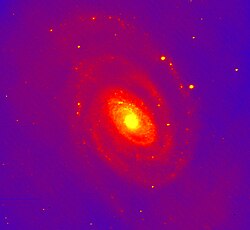Hubble First Light, First Released Image (STScI-1990-04a)
Technical Details: The first image taken with the HST is intended to assist in focusing the telescope. The region observed is centered on the 8.2 magnitude star HD96755 in the open cluster NGC 3532, in the southern constellation Carina. Identical small subsections of the HST and ground-based image pictures were chosen to highlight the difference in resolution. The field shown is approximately 11 x 14 arcseconds in size and does not contain HD96755.
The HST image is a thirty-second exposure taken by the Wide Field/Planetary Camera. The picture shown was extracted from the area observed by the WF-3 OCD using the F555W broadband filter. The measured width of star profiles (FWFM) gives a good indication of the angular resolution. The FWFM of the stars in the HST picture is about 0.8 arcseconds, compared to 1.1 arcseconds for normal ground telescopes, which points out the remarkable increase in resolution of the HST even at this early stage of the focusing task.Relevante Bilder
Relevante Artikel
Erstes LichtAls erstes Licht wird in der Astronomie der Augenblick bezeichnet, in dem zum ersten Mal Licht eines Gestirns auf den Spiegel oder die Linse eines neuen Teleskops fällt. Das gilt nicht nur für das Fernrohr selbst, sondern auch für die daran angeschlossenen Instrumente, denen man ihr jeweils eigenes Erstes Licht zuspricht. Analog spricht man vom ersten Licht eines Radioteleskops, wenn dieses zum ersten Mal Radiowellen empfängt, und die Empfänger in verschiedenen Wellenbereichen können jeweils ihr eigenes erstes Licht haben. .. weiterlesen





